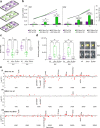Biological hydrogen cyanide emission globally impacts the physiology of both HCN-emitting and HCN-perceiving Pseudomonas
- PMID: 37650608
- PMCID: PMC10653877
- DOI: 10.1128/mbio.00857-23
Biological hydrogen cyanide emission globally impacts the physiology of both HCN-emitting and HCN-perceiving Pseudomonas
Abstract
Bacteria communicate by exchanging chemical signals, some of which are volatile and can remotely reach other organisms. HCN was one of the first volatiles discovered to severely impact exposed organisms by inhibiting their respiration. Using HCN-deficient mutants in two Pseudomonas strains, we demonstrate that HCN's impact goes beyond the sole inhibition of respiration and affects both emitting and receiving bacteria in a global way, modulating their motility, biofilm formation, and production of antimicrobial compounds. Our data suggest that bacteria could use HCN not only to control their own cellular functions, but also to remotely influence the behavior of other bacteria sharing the same environment. Since HCN emission occurs in both clinically and environmentally relevant Pseudomonas, these findings are important to better understand or even modulate the expression of bacterial traits involved in both virulence of opportunistic pathogens and in biocontrol efficacy of plant-beneficial strains.
Keywords: HCN; Pseudomonas; siderophores; volatile.
Conflict of interest statement
The authors declare no conflict of interest.
Figures



References
Publication types
MeSH terms
Substances
Grants and funding
LinkOut - more resources
Full Text Sources
